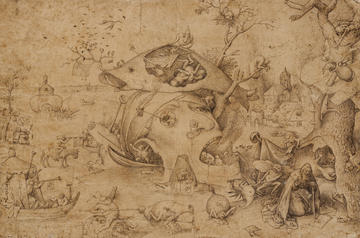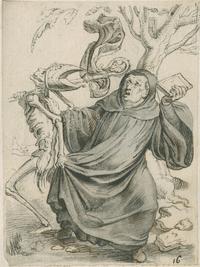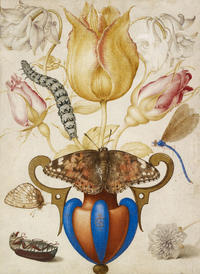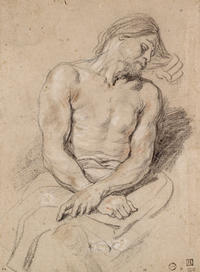19 December 2023:
The Ashmolean’s spring 2024 exhibition will be devoted to some of the finest works of art produced by Flemish masters. Bruegel to Rubens will show 120 of the most outstanding drawings from the 16th and 17th centuries, with over 30 on display for the first time, including some which have only recently been discovered. The majority of the drawings will come from the extraordinary holdings of the UNESCO World Heritage Site, the Museum Plantin-Moretus, Antwerp. They will be joined with the Ashmolean’s unique collections and loans from the Bodleian, Christ Church and private lenders. Many of the drawings from Belgium are topstukken – masterpieces designated by the Flemish Government for their exceptional quality and value.
The exhibition will show a remarkable range of artworks rarely seen in public because of their fragility and sensitivity to light. Among the works on show will be drawings by three of the most famous Flemish artists: Pieter Bruegel the Elder (c. 1525–69), Peter Paul Rubens (1577–1640) and Anthony Van Dyck (1599–1641). The exhibition will also present numerous drawings by other talented draughtsmen, such as Maerten de Vos (1532–1603), Hans Bol (1534–94), and Jacques Jordaens (1593–1678).
These drawings were produced during a period of great change and prosperity in the region known as the Southern Netherlands. This area was a hub of artistic production driven by high demand from the established rural aristocracy, newly monied urban patricians, and many religious orders and professional guilds. All were eager to commission sacred and secular paintings, sculpture and decorative artworks which required preparation in drawing.
This exhibition will be a first for grouping South Netherlandish drawings according to their function in the artist’s studio and beyond, presented in three galleries: as sketches and copies; as preparations for other works; and as independent works of art in their own right. In doing so, the exhibition provides an insight into how these artists honed their drawing skills throughout their careers.
The 120 works on display range from quick scribbles to elaborate studies: from sensitive portraits to compositional studies for paintings; colourful designs for triumphal arches and monumental tapestries; and elaborate sheets made to celebrate friendships. These will be shown together with a selection of related works for which the drawings were designs; and with artworks which inspired them. Overarching themes running across the exhibition include the personal connections and networks forged between these artists, often resulting in collaborations. Many of them travelled extensively, settled abroad and became court artists across Europe, emphasising the broader international achievements of South Netherlandish artists.
To begin with, the show considers studies, made in the studio or out of doors (en plein air), and includes copies of other artworks, such as antique sculpture. A highlight is an album containing tiny drawings by Rubens from around 1590, including his earliest work produced when he was aged just 13: ‘The Abbot and Death’, inspired by a Hans Holbein woodcut. Rubens makes the scene his own, enlivening the action and rendering the skeleton figures more dynamic. There will also be a reconstruction of Rubens’s drawing desk, featuring Ancient Roman busts and coins from the Ashmolean’s collections, similar to those the artist is known to have collected and copied.
The exhibition then explores design-drawings created in preparation for works in other media, including paintings, prints, sculpture, architecture and decorative arts, such as metalwork, stained glass and tapestries.
One of the most striking examples is Bruegel’s ‘The Temptation of St Anthony’ (c. 1556), a hellish vision of demonic creatures across a bleak landscape which recalls the work of Hieronymus Bosch (c. 1450–1516). The drawing is meticulously rendered in pen and brown ink, intended to be made into an engraving by a professional printmaker. The Ashmolean has recently acquired an impression of the print, which will be on display for the first time in the exhibition. In another world first, six tapestry cartoons, designed for one of the Vatican’s ‘Scuola Nuova’ series, will be reunited, revealing how weavers would have used them to create the final work.
Finally, the exhibition looks at drawings made as independent works of art, often for presentation or as gifts to patrons, friends and other artists. Among these are highly finished and painterly ‘cabinet miniatures,’ including a particularly fine example by Joris Hoefnagel – ‘An Arrangement of Flowers in a Vase with Insects’ (1594). This forms part of a display of sheets from ‘friendship albums’ with contributions from many South Netherlandish artists that would have circulated among friends and colleagues.
An Van Camp, Christopher Brown Curator of Northern European Art at the Ashmolean and Exhibition Curator of Bruegel to Rubens, says: ‘This will be the first time these magnificent drawings from Antwerp are brought together with those from the Ashmolean, including some which have only recently been discovered and acquired. Thanks to the generous loan from the Museum Plantin-Moretus, visitors will have a once-in-a-lifetime opportunity to get close to these delicate and rarely displayed works by famous Flemish masters, as well as those by lesser-known artists who deserve a wider audience.’
—ENDS—
CONTACT DETAILS
Claire Parris, Press and Publicity Manager, Oxford University Museums and Garden
claire.parris@glam.ox.ac.uk / 07833 384 512
Sarah Holland, Press Assistant, Oxford University Museums and Garden
sarah.holland@glam.ox.ac.uk / 01865 278 285
PRESS IMAGES
Images for editorial use are available to download at: https://go.glam.ox.ac.uk/BruegeltoRubens
NOTES TO EDITORS
Exhibition: Bruegel to Rubens: Great Flemish Drawings
Dates: 23 March–23 June 2024
Press View: 21 March 2024
Tickets: £7.65–£15.30, available at the Museum or online
Catalogue: £25, available at the Museum or online
CREDITS
The exhibition is co-organised by the Museum Plantin-Moretus, Antwerp, and the Ashmolean Museum, University of Oxford. Part of it was initially presented in Antwerp from 17 November 2023 to 18 February 2024 curated by Virginie D’haene. The adapted exhibition at the Ashmolean is co-curated by An Van Camp and Virginie D’haene. Further information about the Museum Plantin-Moretus here.
The exhibition is supported by:
Ashmolean Patrons
Kathryn Uhde
Delegation of Flanders (Embassy of Belgium)
Visit Flanders
Embassy of Belgium in London
Robert Lehman Foundation
Michael Marks Charitable Trust
Kate de Rothschild Agius and Marcus Agius CBE
Graphius
And those who wish to remain anonymous
Images:
Pieter Bruegel the Elder (c. 1526–69), The Temptation of St Anthony, c. 1556 Ashmolean Museum, University of Oxford
Peter Paul Rubens (1577–1640), after Hans Holbein, The Abbot and Death, c. 1590 Museum Plantin-Moretus, Antwerp
Joris Hoefnagel (1542–1600), Arrangement of Flowers in a Vase with Insects, 1594 Ashmolean Museum, University of Oxford
Anthony van Dyck (1599–1641), Study of a Man with his Hands Crossed, c. 1618–20 Ashmolean Museum, University of Oxford




